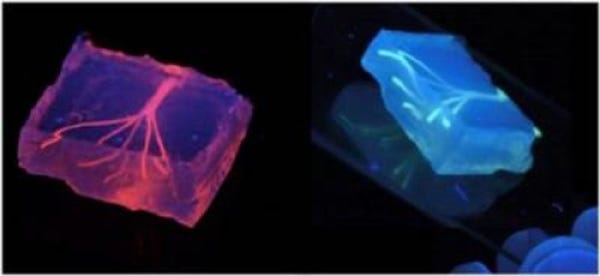September 2, 2014
Progress has been slow in the realm of 3-D printing living tissue and organs. An area of particular frustration has been that of blood vessel development. But the situation is changing, thanks to a team of engineers who recently made significant progress toward the creation of blood vessels using a 3-D bioprinting technique.
Brigham and Women's Hospital researchers were able to create artificial blood vessels by using hydrogel constructs combined with 3-D bioprinting technology. The research team was led by Ali Khademhosseini, PhD, a biochemical engineer and director of the Biomaterials Innovation Research Center at the Boston hospital.
"Engineers have made incredible strides in making complex artificial tissues, such as those of the heart, liver, and lungs," Khademhosseini said in a news release. "However, creating artificial blood vessels remains a critical challenge in tissue engineering. We've attempted to address this challenge by offering a unique strategy for vascularization of hydrogel constructs that combine advances in 3-D bioprinting technology and biomaterials."
|
Brigham and Women's Hospital researchers turned to a unique strategy that combined advances in 3-D bioprinting technology and biomaterials. (Image courtesy of Brigham and Women's Hospital) |
Researchers began by creating an agarose fiber template to serve as the mold for the vessels. Next, they covered the mold with a gelatin-like substance known as hydrogel, forming a cast over the mold that could be reinforced.
"Our approach involves the printing of agarose fibers that become the blood vessel channels," said Khademhosseini. "What is unique about our approach is that the fiber templates we printed are strong enough that we can physically remove them to make the channels. This prevents having to dissolve these template layers, which may not be so good for the cells that are entrapped in the surrounding gel."
The team was then able to successfully embed these functional microchannels inside various commonly used hydrogels at different concentrations. They found that when using methacrylated gelatin laden with cells, their fabricated vascular networks functioned to improve mass transport, cellular viability, and cellular differentiation.
Medical jargon aside, it was a large step in the direction of developing functional artificial blood vessels, and it isn't the only study pushing the boundaries. Recently a team of researchers at Harvard University demonstrated a method for creating tissues interlaced with blood vessels, just one of several recent breakthroughs in 3-D printing technology that are changing the landscape of bioprinting methods, providing a bright future for 3-D printing in medicine.
"In the future, 3-D printing technology may be used to develop transplantable tissues customized to each patient's needs, or be used outside the body to develop drugs that are safe and effective," Khademhosseini said. The potential impact of 3D bioprinting on modern medicine continues to grow as researchers around the globe continue to learn and observe how 3D printing technology can advance modern medicine in the creation of living tissues and organs.
Refresh your medical device industry knowledge at MEDevice San Diego, September 10-11, 2014. |
Kristopher Sturgis is a contributor to Qmed and MPMN.
Like what you're reading? Subscribe to our daily e-newsletter.
About the Author(s)
You May Also Like

